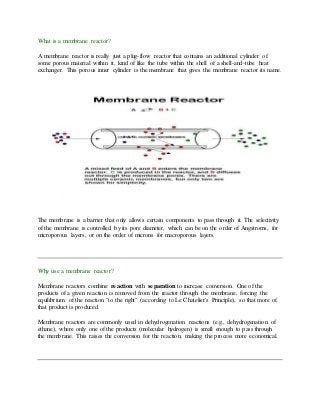
Membrane reactor
- 1. What is a membrane reactor? A membrane reactor is really just a plug-flow reactor that contains an additional cylinder of some porous material within it, kind of like the tube within the shell of a shell-and-tube heat exchanger. This porous inner cylinder is the membrane that gives the membrane reactor its name. The membrane is a barrier that only allows certain components to pass through it. The selectivity of the membrane is controlled by its pore diameter, which can be on the order of Angstroms, for microporous layers, or on the order of microns for macroporous layers. Why use a membrane reactor? Membrane reactors combine reaction with separation to increase conversion. One of the products of a given reaction is removed from the reactor through the membrane, forcing the equilibrium of the reaction "to the right" (according to Le Chatelier's Principle), so that more of that product is produced. Membrane reactors are commonly used in dehydrogenation reactions (e.g., dehydrogenation of ethane), where only one of the products (molecular hydrogen) is small enough to pass through the membrane. This raises the conversion for the reaction, making the process more economical.
- 2. What kinds of membrane reactors are available? Membrane reactors are most commonly used when a reaction involves some form of catalyst, and there are two main types of these membrane reactors: the inert membrance reactor and the catalytic membrane reactor. The inert membrane reactor allows catalyst pellets to flow with the reactants on the feed side (usually the inside of the membrane). It is known as an IMRCF, which stands for Inert Membrane Reactor with Catalyst on the Feed side. In this kind of membrane reactor, the membrane does not participate in the reaction directly; it simply acts as a barrier to the reactants and some products. A catalytic membrane reactor (CMR) has a membrane that has either been coated with or is made of a material that contains catalyst, which means that the membrane itself participates in the reaction. Some of the reaction products (those that are small enough) pass through the membrane and exit the reactor on the permeate side. 1. Mole Balance: For a differential mole balance on A in the catalytic bed at steady state: IN (by flow) - OUT (by flow) + Generation = Accumulation Dividing by and taking the limit as gives: Similarly, a differential mole balance on C in the catalytic bed at steady state will give: IN (by flow) - OUT (by flow) + Generation = Accumulation Dividing by and taking the limit as gives: The steady state, differential mole balance on B looks slightly different, since B is the only species that passes through the membrane:
- 3. IN (by flow) - OUT (by flow) + Generation - OUT (by diffusion) = Accumulation where RB is the molar flowrate of B through the membrane per unit volume of the reactor. Dividing by and taking the limit as gives: 2. Rate Law: The rate of disappearance of reactant A follows the rate law: where k is the specific reaction rate constant, and KC is the equilibrium constant. Products B and C obey the following rate laws: , 3. Transport Law: The transport or flux of species B through the membrane follows the transport law: where km is a mass transport coefficient for the flow of product B through the membrane. 4. Stoichiometry: For gas-phase reactions: 5. Combine: Substituting the concentration terms into the rate law yields: where the total molar flow rate is: and:
- 4. Comparing Membrane Reactors with PFRs:- Changing FA0 Let's take a look at the effects of changing the inlet flowrate, FA0, and how it affects our individual flowrates and the conversion: As expected, our flowrates increase as FA0 increases. Interestingly though, conversion actually decreases as FA0 increases. Why? Even though more of reactant A enters the reactor as the flowrate increases, it spends less time in the reactor, which causes the decrease in conversion. Changing km The transport coefficient, km, is a measure of how easily a species will pass through a given substance (i.e., the membrane). The lower the value of km, the more difficult it will be for species B to pass through the membrane, so it makes sense that our highest conversion occurs when km is highest. (See the page on flux for more information.) The resulting effect on our flowrates is also no surprise, since the removal of species B through the membrane will drive our reaction equilibrium to the right. In our extreme case of large km, species B is removed as quickly as it is produced
